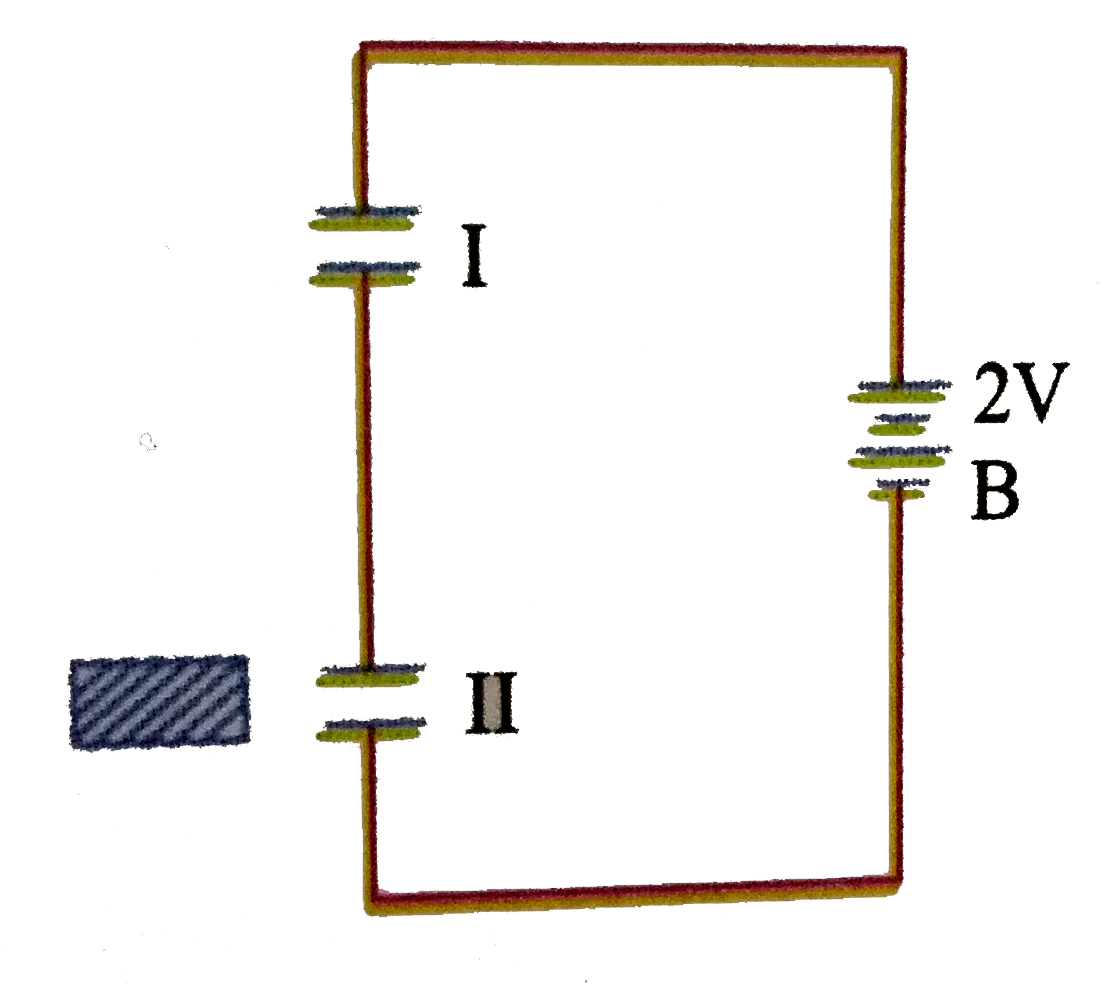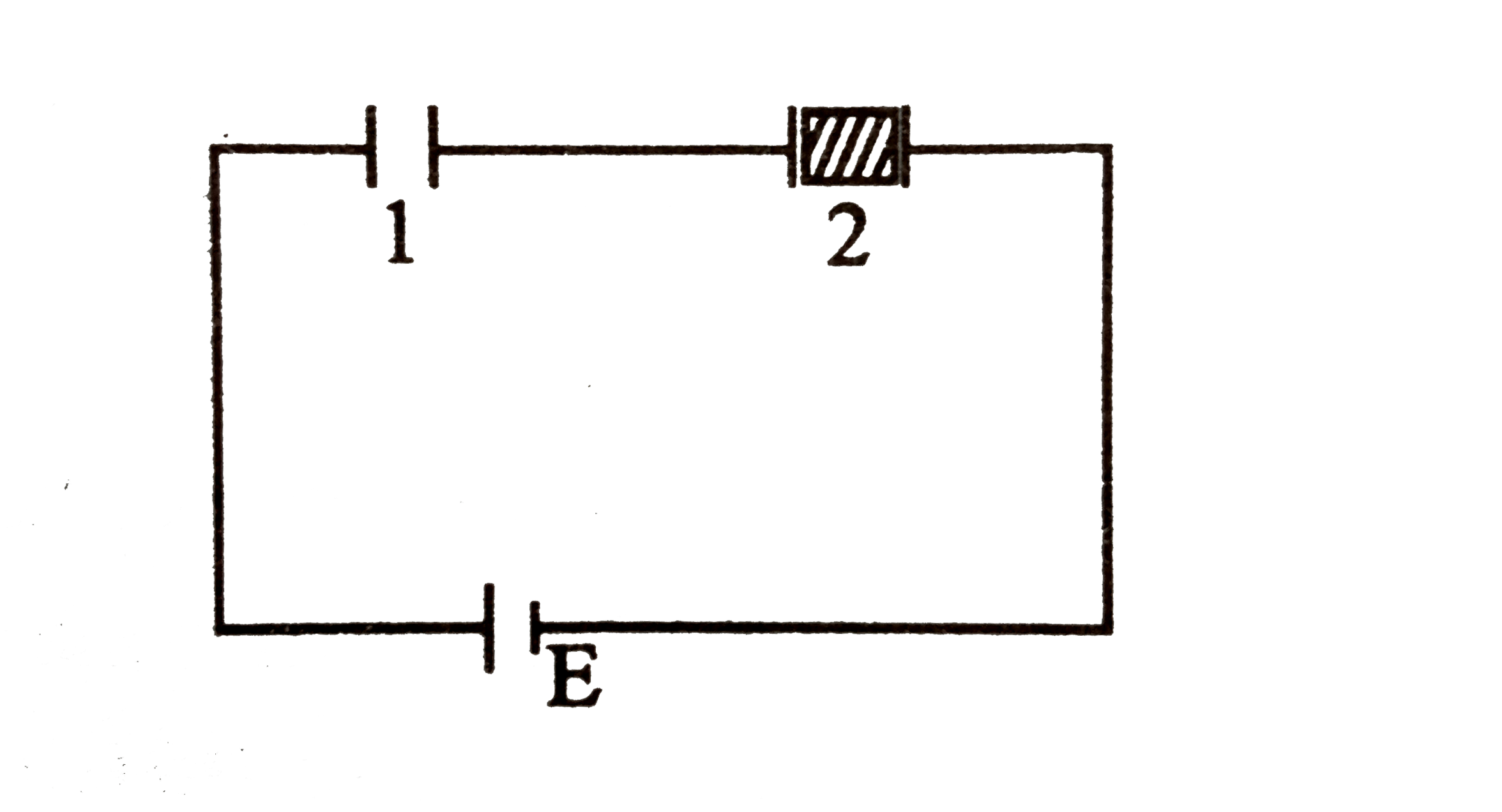Complete Solutions to Level-III (C.W) of chapter CAPACITANCE of Class 12 book with complete answers and questions
| Class 12 | PHYSICS |
| Chapter | CAPACITANCE |
| NARAYANA | Level-III (C.W) |
| Number Of Questions | 41 |
| Academic Year | 2023-24 |
The time in seconds required to produce a `P.D` at `20 V` across a capacitor at `1000 mu F` when it is charged at the steady rate of `200mu C//sec` is.
View SolutionA parallel plate capacitor of capacity `5 mu F` and plate separation `6 cm` is connected to a `1V` battery and is charged. A dielectric of dielectric constant `4` and thickness `4 cm` is introduced into the capacitor. The additional charge that flows into the capacitor from the battery is.
View SolutionThe force between the plates of a parallel plate capacitor of capacitance `C` and distance of separation of the plates `d` with a potential difference `V` between the plates, is.
View SolutionTwo identical capacitors are connected as shown in the figure. A dielectric slab is introduced between the plates of one of the capacitors so as to fill the gap, the battery remaining connected. The charge on each capacitor will be (charge on each condenser is `q_(0) , k=` dielectric constant).
 .
.
View SolutionTwo identical capacitors `1` and `2` are connected in series to a batery as shown in figure. Capacitor `2` contains a dielectric slab of dieletric constant `k` as shown. `Q_(1)` and `Q_(2)` are the charges stored in the capacitors. Now the dielectirc slab us removed and the corresponding charges are `Q'_(1)` and `Q'_(2)`. Then

View SolutionA capacitor of capacitance `C_(1)=1 muF` withstand a maximum voltage of `V_(1)=6 KV`, and another capacitor of capacitance `C_(2)=2 muF`, can with stand a maximum voltage of `V_(2)=4KV`. If they are connected in series, what maximum voltage will the system withstand?
View SolutionEnergy `'E'` is stored in a parallel plate capacitor `'C_(1)'`. An identical uncharged capacitor `'C_(2)'` is connected to it, kept in contact with it for a while and then disconnected, the enegry stored in `C_(2)` is.
View SolutionA parallel plate capacitor has area of each plate `A`, the separation between the plates is `d`. It is charged to a potential `V` and then disconnected from the battery. The amount of work done in the filling the capacitor Completely with a dielectric constant `k` is.
View SolutionA capacitor of capacitance `10 mu F` is charged to a potential `50 V` with a battery. The battery is now disconnected and an additional charge `200 mu C` is given to the positive plate of the capacitor. The potential difference across the capacitor will be.
View SolutionA capacitor is filled with an insulator and a certain potential difference is applied to its pltaes. The energy stored in the capacitor is `U`. Now the capacitor is disconnected from the source and the insulator is pulled out of the capacitor. The work performed against the forces of electric field in pulling out the insulator is `4 U`. Then dielectric constant of the insulator is.
View SolutionA capacitor of capacitance C is charged to a potential difference V from a cell and then disconnected from it. A charge +Q is now given to its positive plate. The potential difference across the capacitor is now
View SolutionA parallel plate capacitor with plates separated by air acquires `1 mu C` of charge when connected to a battery of `500 V`. The plates still connected to the battery are then immersed in benzene `[k = 2.28]`. Then a charge that flows from the battery is.
View SolutionAn air capacitor with plates of area `1 m^(2)` and `0.01 metre` apart is charged with `10^(-6) C` of electricity. When the capacitor is submerged in oil of relative permittivity `2`, then the energy decreases by.
View SolutionThree uncharged capacitors of capacities `C_(1),C_(2)` and `C_(3)` are connected as shown in the figure to one another and the potentials `V_(1),V_(2)` and `V_(3)` respectively. Then the potential at `O` will be
 .
.
View SolutionIn the given figure the capacitor of plate area `A` is charged upto charge `q`. The ratio of elongations (neglect force gravity) in springs `C` and `D` at equilibrium position is.
 .
.
View SolutionIf metal section of shape `H` is inserted in between two parallel plates as shown in figure and `A` is the area of each plate then the equivalent capacitance is.
 .
.
View SolutionThe equivalent capacitance `C_(AB)` of the circuit shown in the figure is.
 .
.
View SolutionA solid conducting sphere of radius `10 cm` is enclosed by a thin metallic shell of radius `20 cm`. A charge `q = 20 mu C` is given to the inner sphere is connected to the shell by a conducting wire.
View SolutionA condenser of capacity `500 mu F` is charged at the rate of `400 mu F` per second. The time required to raise its potential by `40 V` is.
View SolutionThe equivalent capacitance of the arrangement shown in figure, if `A` is the area of each plate is

View SolutionTwo capacitors `C_(1) = 2 muF` and `C_(2) = 6 muF` in series, are connected in parallel to a third capacitor `C_(3) = 4 muF`. This arrangement is then connected to a battery of e.m.f `= 2V`, as shown in the figure. How much energy is lost by the battery in charging the capacitors

View SolutionA capacitor is chared to store an energy `U`. The charging battery is disconnected. An edentical is now connected to the first capacitor in parallel. The energy in each capacitor is now.
View SolutionA parallel plate condenser with a dielectric of dielectric constant K between the plates has a capacity C and is charged to a potential V volt. The dielectric slab is slowly removed from between the plates and then reinserted. The net work done by the system in this process is
View SolutionA fully charged capacitor has a capacitance 'C'. It is discharged through a small coil of resistance wire embedded in a thermally insulated block of specific heat capacity 's' and mass 'm'. If the temperature of the block is raised by 'DeltaT', the potential difference 'V' across the capacitance is
View SolutionA parallel plate capacitor of capacitty `100 mu F` is charged by a battery at `50` volts. The battery remains connected and if the plates of the capacitor are separated so that the distance between them is halved the original distance, the additional energy gives by the battery to the capacitor in Joules is .....
View SolutionThe equivalent capacity between the points `A` and `B` in the adjoining circuit will be.
 .
.
View SolutionA parallel plate capacitor with air as medium between the plates has a capacitance of `10 muF`. The area of capacitor is divided into two equal halves and filled with two media as shown in the figure having dielectric constnt `k_(1) = 2` and `k_(2) = 4`. the capacitance of the system will now be

View SolutionThe capacity of a parallel plate condenser with air medium is `60 mu F` having distance of seperation `d`. If the space between the plates is filled with two slabs each of thickness `^(d)//_(2)` and dielectric constant `4` and `8`, the effective capacity becomes.
View SolutionIn the adjoining diagram, the condenser `C` will be fully charged to potential `V` if
 .
.
View SolutionThe capacity between the point `A` and `B` in the adjoining circuit will be.
 .
.
View SolutionThe capacitance `C_(AB)` in the given network.
 .
.
View SolutionIn the following circuit , find the potentials at points `A` and `B` is.
 .
.
View SolutionThe potential difference between the points `A` and `B` in the following circuit in steady state will be
 .
.
View SolutionIn the following circuit two identical capacitors, a battery and a switch (s) are connected as shown. The switch (s) is opened and dielectric of constant `(K=3)` are inserted in the condensers. The ratio of electrostatic energies of the system before and after filling the dielectric will be.
 .
.
View SolutionIn the given figure a capacitor of plate are `A` is charged upto charge `q`. The mass of each plate is `m_(2)`. The lower plate is rigidly fixed. The value of `m_(1)` if the system remains in equilibrium is.
 .
.
View SolutionOne plate of a capacitor is fixed, and the other is connected to a spring as shown in. Area of both the plates is `A` In strady state (equilibrium), separation between the plates is `0.8d` (spring was unstretched , and the distance between the plates was `d` when capacitor was uncharged). The force conntant of the spring is approximately.

View SolutionA capacitor is made of a flat plate of area A and a second plate having a stair -like structure as shown in figure. The width of each stair is `a` and the height is `b` . Find the capacitance of the assembly.

View SolutionA parallel plate capacitor of capacitance C is connected to a battery and is charged to a potential difference V. Another capacitor of capacitance 2C is ismilarly charged to a potential difference 2V. The charging battery is now disconnected and the capacitors are connected in parallel to each other in such a way that the poistive terminal of one is connected to the negative terminal of the other. The final energy of the configuration is
View SolutionTwo identical capacitors, have the same capacitance C. One of them is charged to potential `V_1` and the other `V_2`. The negative ends of the capacitors are connected together. When the poistive ends are also connected, the decrease in energy of the combined system is
View SolutionConsider the situation shown in the figure. The capacitor `A` has a charge `q` on it whereas `B` is uncharged. The charge appearing on the capacitor `B` a long `7` time after the switch is closed is :
 .
.
View SolutionFind the capacitance of a system of two identical metal balls of radius a if the distance between their centres is equal to `b`, with `b gt gt a`. The system is located in a uniform dielectric with permittivity `K`.
View Solution
Level-III (C.W) questions and complete solutions for chapter CAPACITANCE of NARAYANA PHYSICS (HINGLISH) of Class 12